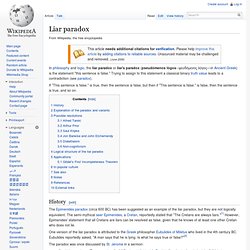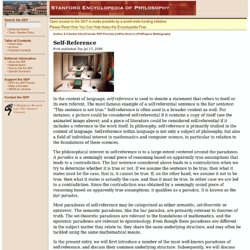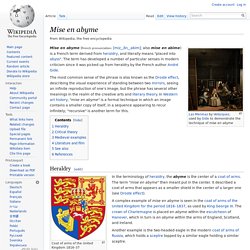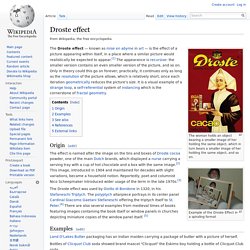

The-treachery-of-images-this-is-not-a-pipe-1948(2) The-pipe-1927(1) Magritte_Rene-The_Two_Mysteries.jpg (JPEG Image, 710 × 601 pixels) The-human-condition-1933(1) Magritte_Rene-The_Two_Mysteries. MagritteRene-Evening_Falls-We@SnF-1. Liar paradox. In philosophy and logic, the liar paradox or liar's paradox (pseudómenos lógos--ψευδόμενος λόγος—in Ancient Greek) is the statement "this sentence is false.

" Trying to assign to this statement a classical binary truth value leads to a contradiction (see paradox). If "This sentence is false. " is true, then the sentence is false, but then if "This sentence is false. " is false, then the sentence is true, and so on. History[edit] The Epimenides paradox (circa 600 BC) has been suggested as an example of the liar paradox, but they are not logically equivalent. The semi-mythical seer Epimenides, a Cretan, reportedly stated that "The Cretans are always liars One version of the liar paradox is attributed to the Greek philosopher Eubulides of Miletus who lived in the 4th century BC. The paradox was once discussed by St. "I said in my alarm, 'Every man is a liar! ' Explanation of the paradox and variants[edit] Self-Reference. First published Tue Jul 15, 2008 In the context of language, self-reference is used to denote a statement that refers to itself or its own referent.

The most famous example of a self-referential sentence is the liar sentence : “This sentence is not true.” Self-reference is often used in a broader context as well. For instance, a picture could be considered self-referential if it contains a copy of itself (see the animated image above); and a piece of literature could be considered self-referential if it includes a reference to the work itself. Mise en abyme. The most common sense of the phrase is also known as the Droste effect, describing the visual experience of standing between two mirrors, seeing an infinite reproduction of one's image, but the phrase has several other meanings in the realm of the creative arts and literary theory.

In Western art history, "mise en abyme" is a formal technique in which an image contains a smaller copy of itself, in a sequence appearing to recur infinitely; "recursive" is another term for this. Heraldry[edit] Coat of arms of the United Kingdom 1816–37. Droste effect. The woman holds an object bearing a smaller image of her holding the same object, which in turn bears a smaller image of her holding the same object, and so on.

The Droste effect — known as mise en abyme in art — is the effect of a picture appearing within itself, in a place where a similar picture would realistically be expected to appear.[1] The appearance is recursive: the smaller version contains an even smaller version of the picture, and so on. Only in theory could this go on forever; practically, it continues only as long as the resolution of the picture allows, which is relatively short, since each iteration geometrically reduces the picture's size. It is a visual example of a strange loop, a self-referential system of instancing which is the cornerstone of fractal geometry.
§Origin[edit] Example of the Droste Effect in a spiraling format §Examples[edit] Land O'Lakes Butter packaging has an Indian maiden carrying a package of butter with a picture of herself. §See also[edit] Droste effect magritte. Diego_Vel%C3%A1zquez_Las_Meninas_Die_Hoffr%C3%A4ulein. Url?sa=t&rct=j&q=&esrc=s&frm=1&source=web&cd=1&ved=0CC0QFjAA&url=http%3A%2F%2Farthumanities-crowley.wikispaces.com%2Ffile%2Fview%2FFoucault_Meninas.pdf&ei=Uv6eUvH2Meqq7Qbl44DwDA&usg=AFQjCNHPGobDWi0q7N5Mka89xhJuXK5xRQ&bvm=bv.57155469,d.